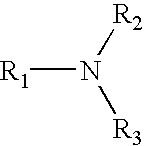Epichlorohydrin-based polymers containing primary amino groups used as additives in papermaking
a technology of epichlorohydrin and polymer, which is applied in the field of production of paper and paper board and to a polymer additive, can solve the problems of affecting product quality, affecting the retention of papermaking materials, and loss of valuable papermaking materials, and achieve the effect of enhancing the retention of components of papermaking stock
- Summary
- Abstract
- Description
- Claims
- Application Information
AI Technical Summary
Benefits of technology
Problems solved by technology
Method used
Image
Examples
embodiment 1
Highly Branched Polymer Containing Primary Amino Groups
[0047] A highly-branched polymer, with primary amino groups was obtained by a slow addition of equimolar amount of epichlorohydrin (ECH) to aqueous ammonia, at a temperature of 70-75° C. Under these conditions, ammonia reacts with epichlorohydrin first by displacing an atom of chlorine with an amino group and then by opening the oxirane ring to form 1,3-diamino-2-propanol (1).
[0048] At elevated temperature used in this synthesis, the primary amino groups of (1) react with additional molecules of epichlorohydrin to form a branched structure (2-Cl), which contains four chlorine atoms in the form of α-halohydrins. These chlorine atoms react with additional ammonia to form the compound (2-N), which has four primary amino groups. Each of these four primary amino groups can again react with two molecules of epichlorohydrin to form a compound containing eight atoms of chlorine. Such branching of this molecule continues until all epi...
example 1
Synthesis of Highly Branched, Starbursts Polymer Containing Primary Amino Groups and Evaluation of its Effect on Retention
[0052] 48.6 g of a 28% solution of ammonium hydroxide containing 0.8 mol of ammonia was diluted with 189.2 g of deionised water and heated to 75° C. During 1 h 73.6 g of epichlorohydrin (also 0.8 mol) were slowly added to the agitated solution. The reaction mixture was then heated for 2 h to 90-95° C. The yield was 92.1% of product with a pH value of 4.7 and a concentration of 28%. The material obtained in this manner had very high charge density, namely 4.39 meq / g at pH 4.
[0053] Laboratory tests demonstrated that this compound is a very effective coagulant; suitably cationic polyacrylamide is used as a flocculent. This dual retention system was found to be suitable even for a strongly anionic furnish containing peroxide bleached TMP. In the test a furnish from an Eastern Canadian mill was used, that was composed of 47% of peroxide-bleached TMP, 45% of unbleach...
embodiment 2
Cross-Linked Highly Branched Polymer Containing Amino Groups
[0054] The reaction of excess epichlorohydrin with ammonia at a temperature below 20° C. was found to lead to the formation of tris(3-chloro-2-hydroxypropylamine) abbreviated as (TCH)Cl3 (4). At this low temperature and with an excess of ECH, the reaction stops at compound (4). In the absence of ammonia, no further branching via compound (3) can occur.
[0055] The reaction of (4) with ethylenediamine (EDA) leads first to an intermediate (5) in which the chlorine atoms are replaced by radicals derived from EDA. The amino groups of (5) can react with the chlorine atoms of additional molecules of compound (4) etc. The product is a highly branched cross-linked polymer of high molecular weight with a multitude of amino groups (6).
[0056] This polymer (6) again resembles dendrimers in that it is a highly branched polymer, but it differs in that it does not have a regular “starburst” structure, rather its extensive branching is ...
PUM
| Property | Measurement | Unit |
|---|---|---|
| Dimensionless property | aaaaa | aaaaa |
| Dimensionless property | aaaaa | aaaaa |
| Weight | aaaaa | aaaaa |
Abstract
Description
Claims
Application Information
 Login to View More
Login to View More - R&D
- Intellectual Property
- Life Sciences
- Materials
- Tech Scout
- Unparalleled Data Quality
- Higher Quality Content
- 60% Fewer Hallucinations
Browse by: Latest US Patents, China's latest patents, Technical Efficacy Thesaurus, Application Domain, Technology Topic, Popular Technical Reports.
© 2025 PatSnap. All rights reserved.Legal|Privacy policy|Modern Slavery Act Transparency Statement|Sitemap|About US| Contact US: help@patsnap.com



